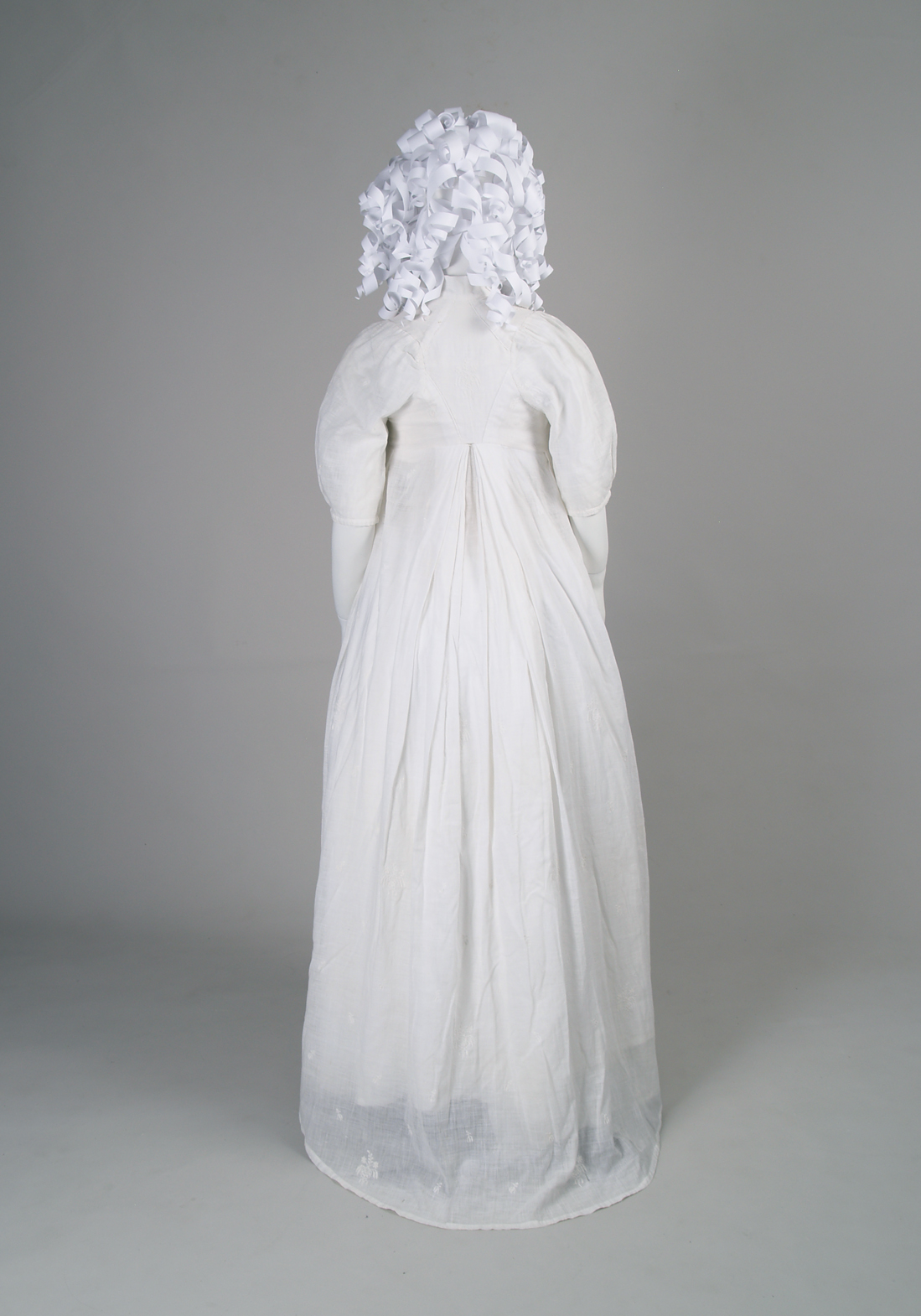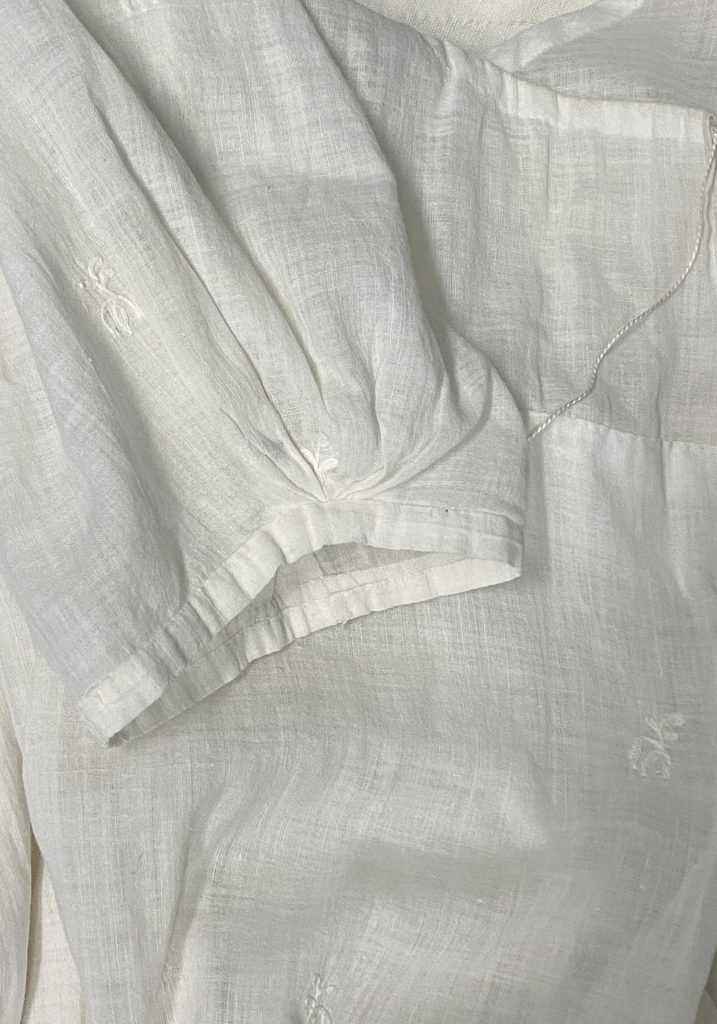
White Mull Chemise Dress
Unknown maker and place of origin
Sprigged mull (i.e. embroidered cotton plain weave)
Date of garment: 1780s, 1790s, or early 1800s
Anne Lambert Clothing & Textiles Collection, Department of Human Ecology, University of Alberta
Accession # 2019.8.1
2019 purchased from Cora Ginsburg LLC (Sharon, USA)

Figure 1
Pattern Diagram 2019.8.1
 |
 |
| Figure 2 2019.8.1: Front View Paper hair by Emily Graca, undergraduate student, and Anne Bissonnette. Mount and photograph by ©Anne Bissonnette. |
Figure 3 2019.8.1: Side View Paper hair by Emily Graca, undergraduate student, and Anne Bissonnette. Mount and photograph by ©Anne Bissonnette. |
 |
 |
| Figure 4 2019.8.1: Back View Paper hair by Emily Graca, undergraduate student, and Anne Bissonnette. Mount and photograph by ©Anne Bissonnette. |
Figure 5 2019.8.1: Detail of Sprigged Mull Fabric Photograph by ©Anne Bissonnette. |
 |
| Figure 6 2014.1.2: Detail View of Selvedge Photograph by ©Anne Bissonnette. |
 |
| Figure 7 2014.1.2: Detail View of Back Bodice and the Piecing Between the Bodice and Skirt at the “Bodice Centre Back” Pieces. Photograph by ©Anne Bissonnette. |
 |
| Figure 8 2019.8.1: Detail of Sleeve Cuff Photograph by ©Anne Bissonnette. |
 |
| Figure 9 2019.8.1: Inside View Detail Photograph by ©Anne Bissonnette. |
*
Observations
This ca. 1780s-early 1800s “sprigged” (i.e. embroidered) cotton mull chemise dress features a drawstring centre-front closure at the neckline and an elevated waistline. The below-the-elbow unlined sleeves are gathered over the shoulder and have two inverted box pleats secured by a narrow cuff (Figure 8), presenting a fullness not unlike the sleeves of a “chemise” (i.e. a woman’s linen undergarment also called a shift). This gown also has a rounded neckline similar to a chemise with the exception of a rectangular standing collar towards the back.
Under the fragile mull bodice is a lining structure of plain-woven cotton or linen. This structure comprises three pattern pieces: the same “bodice back middle” piece as the mull bodice, the “bodice lining front and back side” piece and the “bodice lining shoulder” piece. The narrow, diamond-shaped “bodice back middle” pattern piece is in a whiter fabric than the rest (Figure 9). The “bodice lining front and back side” piece is detached from the mull bodice at the side seam (i.e. the “bodice front” and “bodice back side” intersection). This lining piece gets superimposed over the wearer’s bust and fastened with pins (Figure 7) and thus protects the mull fabric from tension.
The unlined skirt is full length, can be A-line or columnal, and has a train. If the skirt did not have a train, its hem circumference would be 206 cm, which accommodates an extremely wide stride. The “skirt front” pattern piece has no pleats or gatherings at the waistline. The “skirt back” pattern piece has a triple inverted box pleat at the centre back (CB) with each pleat ca. 0.2 cm from one another. There are also two pleats near the side that are folded towards the CB on this pattern piece.
The mull fabric used is very wide (over 125 cm) and is embroidered in white with small cutwork and chain-stitched floral motifs (Figure 5). These floral motifs were likely added before the garment was cut as some motifs are cropped into seams.
Of importance:
- The use of white cotton mull, the cut and volume of the sleeve, and the round neckline of the gown serve to identify the garment as a chemise dress.
- This garment contains no selvage-to-selvage widths. The widest panel is the back skirt, which measures approximately 125 cm at its widest point.
- The lack of darts on the “bodice front” and “bodice lining front and back side” pattern pieces may suggest the gown was worn over traditional conical stays that do not delineate individual breast volumes.
- While the circumference of the skirt portion is narrowing in comparison to earlier gowns (206 cm if the skirt did not have a train), the use of one or more petticoats remains possible.
- This pattern was created early on in our pattern-taking project, therefore it was not done using the streamlined method referenced in the website’s introduction. As such, this pattern and the accompanying construction notes lack some details.
Pattern Notes:
Pattern diagram:
- All descriptions use proper left and right, unless otherwise specified.
- All patterns are placed on the grid, which corresponds to the grain line.
- Seam allowances are not included.
- The “collar,” “bodice back middle,” and “sleeve cuff” pattern pieces are presented fully, while the remaining pattern pieces are presented for one side of the body (e.g. the sleeve pattern piece is for the left sleeve only).
Garment materials:
- The selvedge is not visible so the width of the cotton mull is unknown.
- The gown is completely hand-sewn and has only a cord at the centre front neckline as a closure.
Assembly of pieces:
- The “bodice lining front” pattern piece is longer than the outer mull “bodice front” piece. The notch on the former indicates where the latter ends.
- The “skirt front” pattern piece is cut along the centre-front fold from the elevated waistline to the notch to create the centre-front opening slit.
To download a PDF version of this information, click here.
Last revised June 28, 2024
This garment has also been part of the virtual exhibition Dress & Escapism Series ― Part 1: Dress Artifacts & Curatorial Practices (2020) where it is dressed with a broad and a narrow waist sash.
ALCTC Pattern Project team members
Principal Investigator
Anne Bissonnette, PhD
Curator, Anne Lambert Clothing & Textiles Collection
Professor, Material Culture and Curatorship
Co-Principal Investigator
Katelin Karbonik, MA
Associate Curator, Anne Lambert Clothing & Textiles Collection, October 2022-March 2024
CAD Design
Siming Guo, PhD
Graduate Research Assistant, May-August 2022
This research was funded by the Government of Canada’s Reopening Fund for Heritage Organizations – Museums Assistance Program, and the Social Sciences and Humanities Research Council.

Virtual Exhibition
